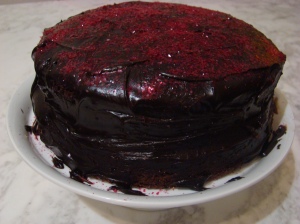Continuing with my Christmas theme, I wanted to share my Christmas Trifle recipe. Cherries are abundant in Australia at Christmas time, so I have combined cherries with the more traditionally European Christmas flavours of gingerbread and mulled wine inspired custard. If you can’t get fresh cherries you could use tinned or jarred cherries, but I don’t recommend you use maraschino cherries.
This recipe uses quantities when you are cooking for a crowd, for occasions when you are asked to bring a desert to share for a large family or other Christmas gathering. You may end up with extra gingerbread left over depending on the size of the serving dish(es) you use. If you are catering for smaller numbers, you could half the quantities of everything and make a smaller batch of trifle.
If you are catering for vegetarians, vegetarian jelly is available from Kosher or Asian supermarkets. You could make some alcohol free trifles for the kids with a cherry or berry jelly, then use port wine jelly for the brandy infused adults version.
The gingerbread does seem to have an alarming amount of sugar and golden syrup, but the spices do balance this out and you end up with a sticky gingerbread.
I mentioned in my candy cane chip chocolate ice cream post, if you are worried about your custard splitting or turning into scrambled eggs, half fill the sink with cold water and ice cubes so that you can set the saucepan in the cool water to immediately stop the cooking once it starts to thicken. If you do happen to split the custard slightly, you can sometimes save it by blending thoroughly in a blender to recombine everything (after removing the vanilla bean, cinnamon stick, star anise and cloves).
Gingerbread Trifle
Ingredients
- 500g cherries, pitted [you might need plastic gloves for this because cherries can stain your hands, clothes, etc.]
- 2 packets jelly
- Gingerbread
- Spiced custard
Method:
- Make the gingerbread and spiced custard according to the recipes below. Allow gingerbread and custard to cool completely.
- Make the jelly according to packet instructions and refrigerate until almost set.
- You can either make individual trifles in small glass cups / bowls, or a large one. I like to use glass so that you can see all the layers. Add a layer of gingerbread to the bottom of the bowl[s]. Next add cherries, then top with custard, leaving about 1cm at the top for the jelly
- Gently spoon over the almost set jelly and refrigerate the whole lot until set and ready to eat.
Gingerbread recipe
Ingredients
- 2 cups self-raising flour
- 2 teaspoons ground ginger
- 1 teaspoon ground cinnamon
- ½ teaspoon mixed spice
- 1 cup milk
- 1 cup sugar
- 2 eggs, lightly beaten
- 125g butter
- 1 cup golden syrup
Method
- Melt butter and syrup in saucepan over low heat until butter is melted.
- Add the flour & spices together into food processor bowl. Add sugar eggs, milk and butter syrup and mix well [or if you don’t have a food processor use a mixer or beaters or wooden spoon].
- Pour into tins – I use cupcake tins. Bake for 40 minutes at 170°C [fan-forced] or 180°C normal oven. Remove from oven when cooked – ie skewer comes out clean or the gingerbread springs back with lightly touched.
Spiced Custard
Ingredients:
- 500mls full cream milk
- 500mls thickened cream
- 100g sugar
- 5 large egg yolks and 5 large whole eggs
- 2 vanilla pods or 1 tspn vanilla paste or 2 tspns vanilla essence
- zest from one orange
- 6 whole cloves
- 1 cinnamon stick
- 1/2 teaspoon ground nutmeg or mace
- 1 star anise
- 2 tablespoons brandy [or calvados – apple brandy] *optional*
Method
- Put the milk and cream in a saucepan with the sugar.
- Split vanilla pod in half, scrape out seeds, add vanilla seeds to the pan, together with the scraped pods. [Or just add the vanilla paste or essence if using.]
- Add the cloves, cinnamon stick, nutmeg or mace, star anise, eggs and egg yolks.
- Whisk to combine the eggs, and place the saucepan on medium heat on the stove top.
- Cook, stirring continuously with a wooden spoon until it thickens.
- Immediately remove the pan from the heat, add the brandy (if using) and strain the custard through a sieve into a chilled bowl or jug. Cover and allow to cool.
What is your favourite dish to bring along to a large get together? Has this post inspired any new ideas?













